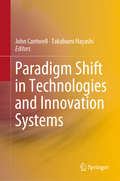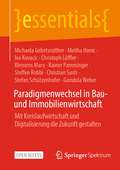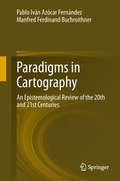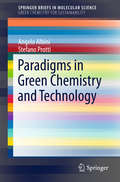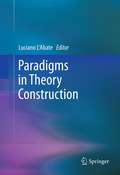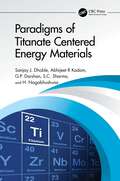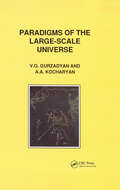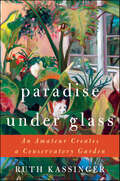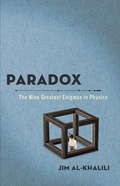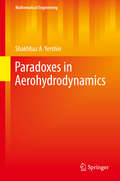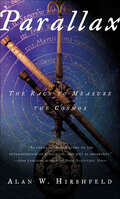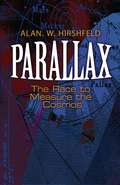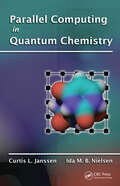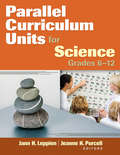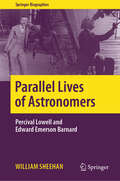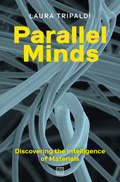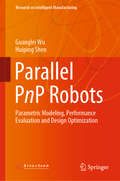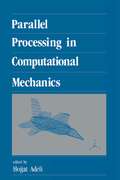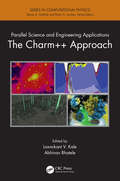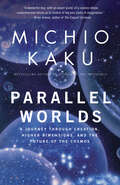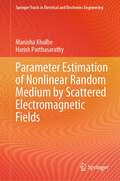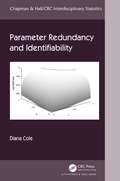- Table View
- List View
Paradigm Shift in Technologies and Innovation Systems
by John Cantwell Takabumi HayashiThis book provides some new ideas on the conceptualization of a shift in technological paradigm, and it explores in depth the relevance of this concept for research on innovation systems. It examines text-mining software and analyzes patent data as well as academic and business journals to illustrate the paradigm shift of newly emerging technologies, such as the all-solid-state battery and automatic driving for electric vehicles, and surgical robots. It also explores the critical role of emerging software technologies by examining US, EU, and Japanese patent statistics.Highlighting the paradigm shift of technologies since the 1990s and the geographical dispersion of innovative capabilities, it identifies essential trends toward new innovation systems as well as the concentration and dispersion of national and corporate R&D capabilities that have taken place as a result.In this new paradigm, the competitiveness of a company is decisively determined by other innovations in systems and management. Since the 1990s, when a network economy began to be established and technological know-how came to be easily transferred across borders, the changing structure of technological activities has required organizations with traditional integral and closed architecture models to move toward open innovation or modular architectures. These changes involve wider technological areas and cognitive diversity among international inter-firm and intra-firm R&D networks.This book is highly recommended not only to academicians but also to business people seeking an in-depth and up-to-date overview of the paradigm shift of technologies and new innovation systems.
Paradigmenwechsel in Bau- und Immobilienwirtschaft: Mit Kreislaufwirtschaft und Digitalisierung die Zukunft gestalten (essentials)
by Christoph Löffler Michaela Gebetsroither Meliha Honic Iva Kovacic Klemens Marx Rainer Pamminger Steffen Robbi Christian Sustr Stefan Schützenhofer Gundula WeberDer vorliegende Open-Access-Band gibt einen umfassenden Einblick in aktuelle europäische und nationale Anforderungen zur Kreislaufwirtschaft im Bau- und Immobilienwesen. Es beleuchtet die Entwicklungen der Gebäudezertifizierungen sowie die aktuellen Möglichkeiten digitaler Gebäudepässe. Zudem wird erörtert, wie Building Information Modelling BIM verwendet werden kann, um Bauwerksdaten schnell und strukturiert zur Verfügung zu stellen und langgfrisitig entlang der Wertschöpfungskette zu dokumentieren. In einem verlinkten online-Artikel findet sich ergänzend die Beschreibung eines Demoprojektes und eine ausführliche Kriterienliste zum kreislauffähigen Planen und Bauen.
Paradigms in Cartography
by Pablo Iván Azócar Fernández Manfred Ferdinand BuchroithnerIn this book the main trends, concepts and directions in cartography and mapping in modernism and post-modernism are reviewed. Philosophical and epistemological issues are analysed in cartography from positivist-empiricist, neo-positivist and post-structuralist stances. In general, in cartography technological aspects have been considered as well as theoretical issues. The aim is to highlight the epistemological and philosophical viewpoint during the development of the discipline. Some main philosophers who have been influential for contemporary thinking such as Immanuel Kant, Ludwig Wittgenstein, Karl Popper and Bertrand Russell, are considered. None of these philosophers wrote about cartography directly (excepting Kant), but their philosophies are related to cartography and mapping issues. The book also analyses the concept of paradigm or paradigm shift coined by Thomas Kuhn, who applied it to the history of science. Different cartographic trends that have arisen since the second half of the twentieth century are analysed according to this important concept which is implicit inside the scientific or disciplinary communities. Further, the authors analyse the position of cartography in the context of the sciences and other disciplines, adopting a positivistic point of view. Additionally, they review current trends in cartography and mapping in the context of information and communication technologies in a post-modernistic or post-structuralistic framework. Thus, since the 1980s and 1990s, new mapping concepts have arisen which challenge the discipline's traditional map conceptions.
Paradigms in Green Chemistry and Technology
by Angelo Albini Stefano ProttiThis brief discusses the formation of modern "green chemistry" as a contribution to sustainability and the historic paths that lead to the key concepts of this discipline. Within this intellectual framework, the book tackles the 12 principles of green chemistry and the 12 principles of green chemical engineering as well as related financial and management issues; these facts are explored and reformulated in a focused set of paradigms. The best choice of a model for quantitative assessment (sufficiently specific to account for the many parameters involved but not excessively detailed to inhibit practical use) is discussed and examples of practical applications are presented.
Paradigms in Theory Construction
by Luciano L'AbateWithin the field of psychology there is a proliferation of paradigms, theories, models, and dimensions without an underlying conceptual framework or theory. This conclusion has been reached by representatives of many different psychological specialties. In response to this inconsistency this book presents a hierarchical framework about important theoretical issues that are present in psychological thinking. These issues concern definitions of three major theoretical concepts in theory and practice: (a) paradigms, (b) theories, and (c) models. It focuses on defining, comparing, and contrasting these three conceptual terms. This framework clarifies differences among paradigms, theories, and models, terms which have become increasingly confused in the psychological literature. Paradigms are usually confused with theories or with models while theories are confused with models. Examples of misuses of these terms suggest the need for a hierarchical structure that views paradigms as conceptual constructions overseeing a variety of psychological theories and verifiable models.
Paradigms of Titanate Centered Energy Materials
by Sanjay J. Dhoble S.C. Sharma Abhijeet R Kadam G.P. Darshan H. NagabhushunaTitanate-centered perovskites are an important class of crystalline materials with outstanding structural and property tunability. Recently, titanate perovskites have been extensively investigated as new-generation materials for various energy-allied applications, together with photovoltaic cells, light emitting diodes, photo detectors and lasers, for their exceptional optical and electronic properties. With increasing attention on the development of nanotechnology and multidisciplinary research, scientists have been trying to downscale the titanate perovskite structures into the nanoregime, so as to further boost their performances and applications. Compared with bulk perovskite materials, perovskite nanomaterials exhibit a series of advantages, such as fabrication of thin films and flexible devices and PNMs display high process ability. Perovskite nanomaterials feature rich and controllable facets and active sites. Besides benefiting from the small-size effect and quantum effect, perovskite nanomaterials are endowed with outstanding photo-electromagnetic properties. Furthermore, the applications of titanate-centered perovskites in the fields of energy, environment, WLEDs, forensic science and piezoelectric devices will be reviewed. This book will also discuss the possible solutions to the problems in their application by optimizing their compositions, structures and preparation methods. This book will systematically summarize the key points in the design, synthesis, property improvements and application expansion of titanate-centered perovskites. The different perovskite structures and the rational design of functional materials will be discussed in detail. The advantages, disadvantages and experimental parameters of different synthesis methods for titanate-centered perovskites will be reviewed. This book will also summarize some practical experiences in selecting suitable elements and designing multifunctional materials according to the mechanisms and principles of elements promoting the properties of perovskites by covering almost last 20 years of literature. At the end of this book, we will provide an outlook on the opportunities and challenges in the view of development in titanate-centered perovskites The inclusive effectiveness and practicality of prospective titanate energy materials and systems are directly connected to many materials-related factors. This volume of book features totally seven sections that envelop a wide range of titanate energy materials. They cover the modern developments involving materials for alternative and renewable energy sources and systems, including energy storage and batteries, nanocomposites, hydrogen, solar, wind, geothermal, biomass and nuclear. The book is a significant orientation for students and researchers (from academics, but also industry) interested in understanding the properties of emerging titanate energy materials and challenges in the recent era.
Paradigms of the Large-Scale Universe
by Grigor A. GurzadyanDynamical systems provide powerful methods for the study of profound properties of many-dimensional nonlinear systems. In this unique book, the authors offer a consistent geometrical treatment of observational cosmology from the concepts of the theory of dynamical systems. The dynamics of clusters of galaxies differ drastically from stellar dynamics, thus requiring a mathematical approach to large-scale problems. Since mathematical techniques are not a familiar tool in this field, a full summary of the elementary ideas of differential geometry, ergodic theory and catastrophe theory are also considered in this exploratory text. Readership: Mathematicians, astrophysicists, and cosmologists, as well as anyone interested in the many subject disciplines related to geometrical and topological aspects of the large-scale universe.
Paradigms on Technology Development for Security Practitioners (Security Informatics and Law Enforcement)
by Babak Akhgar Stefanos Vrochidis Dimitrios Kavallieros Nikolai Stoianov Ilias Gkotsis Dimitrios DiagourtasThis open access book is authored by a rich mix of contributors from across the landscape of research, academia, LEAs, civil protection, and other first responders, practitioners, public and private organizations and industry to address some of the most contemporary challenges within global security domain. The authors cover topics such as protection of critical infrastructures (CI), serious and organized crime, counter (cyber) terrorism, border management, cybercrime, cybersecurity, management of disasters and crises, big data analytics, the application of AI and the legal and ethical dimensions of the implementation of cutting-edge technologies. The book benefits from research actions and lessons learned from more than 35 EU R&D projects within the security domain. The book not only addresses theoretical narratives pertinent to the subject but also identifies current challenges and emerging security threats, provides analysis of operational capability gaps, real world applied solutions, methodologies, and case studies within security domain. This is an open access book.
Paradise Lost and the Cosmological Revolution
by Dennis DanielsonThis volume brings John Milton's Paradise Lost into dialogue with the challenges of cosmology and the world of Galileo, whom Milton met and admired: a universe encompassing space travel, an earth that participates vibrantly in the cosmic dance, and stars that are "world[s] / Of destined habitation. " Milton's bold depiction of our universe as merely a small part of a larger multiverse allows the removal of hell from the center of the earth to a location in the primordial abyss. In this wide-ranging work, Dennis Danielson lucidly unfolds early modern cosmological debates, engaging not only Galileo but also Copernicus, Tycho, Kepler, and the English Copernicans, thus placing Milton at a rich crossroads of epic poetry and the history of science.
Paradise Under Glass: The Education of an Indoor Gardener
by Ruth KassingerParadise Under Glass is a witty and absorbing memoir about one woman’s unlikely desire to build, stock, and tend a small conservatory in her suburban Maryland home. Ruth Kassinger’s wonderful story of the unique way she chose to cope with the profound changes in her life—a book that will delight readers of Eat, Pray, Love and I Feel Bad About My Neck—is interwoven with the fascinating history of conservatories from the Renaissance orangeries to the glass palaces of Kew.
Paradox
by Jim Al-KhaliliA fun and fascinating look at great scientific paradoxes. Throughout history, scientists have come up with theories and ideas that just don't seem to make sense. These we call paradoxes. The paradoxes Al-Khalili offers are drawn chiefly from physics and astronomy and represent those that have stumped some of the finest minds. For example, how can a cat be both dead and alive at the same time? Why will Achilles never beat a tortoise in a race, no matter how fast he runs? And how can a person be ten years older than his twin? With elegant explanations that bring the reader inside the mind of those who've developed them, Al-Khalili helps us to see that, in fact, paradoxes can be solved if seen from the right angle. Just as surely as Al-Khalili narrates the enduring fascination of these classic paradoxes, he reveals their underlying logic. In doing so, he brings to life a select group of the most exciting concepts in human knowledge. Paradox is mind-expanding fun.
Paradoxes in Aerohydrodynamics
by Shakhbaz A. YershinThis book, on the general topic of hydroaerodynamics, investigates anumber of exciting applications in this field, addressing specifically issuesthat allow seemingly paradoxical issues to be dealt with. The first part is devoted to the study of channel flows, in particularthe lateral flow of a viscous and viscous-plastic liquid in a ring channelformed by coaxial cylinders. Specifically, the problem of dissipation ofmechanical energy in channel flows of highly viscous liquids is addressed andsolved. Furthermore, the mechanism leading to hydrodynamic erosion inintra-field pipelines (known as "channelized effect") is identified. Subsequently, a theory for channel flows with mass transfer through porous wallsis developed. In the second part, viscous liquid free flows (jets) are investigated. In particular, a dispersion law for turbulent flow is derived and the existenceof dynamic invariance in wake flows of variable density is demonstrated. The third part presents new insights from both theoretical andexperimental research into concentrated vortex structure formation anddevelopment. The conditions for the existence of Taylor-Goertler vortices aredetermined and the mechanism for their formation is described. Last but notleast, the theory of vortex rings, a particularly interesting problem inhydroaerodynamics, is introduced in the last section of this book. Care has been taken, when selecting original theoretical problems ofinterest, to make the link with related topics in the published literature. Atthe same time, all experimental research described in this book is given ameaningful physical interpretation and corroborated by suitable theoreticalmodels and computations.
Paradoxes in Probability Theory
by William EckhardtParadoxes provide a vehicle for exposing misinterpretations and misapplications of accepted principles. This book discusses seven paradoxes surrounding probability theory. Some remain the focus of controversy; others have allegedly been solved, however the accepted solutions are demonstrably incorrect. Each paradox is shown to rest on one or more fallacies. Instead of the esoteric, idiosyncratic, and untested methods that have been brought to bear on these problems, the book invokes uncontroversial probability principles, acceptable both to frequentists and subjectivists. The philosophical disputation inspired by these paradoxes is shown to be misguided and unnecessary; for instance, startling claims concerning human destiny and the nature of reality are directly related to fallacious reasoning in a betting paradox, and a problem analyzed in philosophy journals is resolved by means of a computer program.
Parallax: The Race to Measure the Cosmos (Dover Books On Astronomy Ser.)
by Alan W. HirshfeldIn the dramatic tradition of the best-selling Longitude, Parallax charts the historical path of observational astronomy's most daunting challenge: measuring the distance to a star. The greatest scientific minds applied themselves in vain to the problem across the millennia, beginning with the ancient Greeks. Not until the nineteenth century would three astronomers, armed with the best telescopes of the age, race to conquer this astronomical Everest—their contest ending in a virtual dead heat. Against a sweeping backdrop filled with kidnappings, dramatic rescue, swordplay, madness, and bitter rivalry, Alan Hirshfeld brings to life the heroes of this remarkable story. Meet the destitute boy plucked from a collapsed building who becomes the greatest telescope maker the world has ever seen; the hot-tempered Dane whose nose is lopped off in a duel over mathematics; the merchant's apprentice forced to choose between the lure of money and his passion for astronomy; and the musician who astounds the world by discovering a new planet from his own backyard. Generously illustrated with diagrams, period engravings, and paintings, Parallax is an unforgettable tale that illuminates the distinctly human side of science.
Parallax: The Race to Measure the Cosmos (Dover Books on Astronomy)
by Alan W. HirshfeldThis lively and entertaining history of the long struggle to measure the distance to the stars will appeal to general readers as well as amateur and professional astronomers. Readers will encounter fascinating historical characters, from ancient Greeks to19th-century scientists. Well illustrated, with contemporary pictures plus extensive notes on further reading.
Parallel Computing in Quantum Chemistry
by Curtis L. Janssen Ida M. NielsenAn In-Depth View of Hardware Issues, Programming Practices, and Implementation of Key MethodsExploring the challenges of parallel programming from the perspective of quantum chemists, Parallel Computing in Quantum Chemistry thoroughly covers topics relevant to designing and implementing parallel quantum chemistry programs. Focu
Parallel Curriculum Units for Science, Grades 6-12
by Dr Jann H. Leppien Dr Jeanne H. PurcellBreathe new life into science learning with this powerful guidebook that shows how to create more thoughtful curriculum and differentiate lessons to benefit all students.
Parallel Lives of Astronomers: Percival Lowell and Edward Emerson Barnard (Springer Biographies)
by William SheehanUsing the "Parallel Lives" approach adopted by the Greek biographer Plutarch, noted historian of astronomy William Sheehan contrasts the lives and research careers of two famous astronomers, Percival Lowell and Edward Emerson Barnard. Drawing on vast archival materials and hitherto unpublished source materials, Sheehan documents in detail the contributions of these two late 19th and early 20th astronomers. Living at a time when controversies about Mars peaked, when great observatories were being built, and when research increasingly turned away from the Solar System toward the stellar and extra-galactic universe, these observers made spectacular contributions to astronomy. Their work still inspires, and continues in Perseverance rover's explorations of the surface of Mars carrying forward Lowell's dream of showing that Mars may once have been "the abode of life," and in Barnard's pioneering wide-angle photographs of the Milky Way which first showed the sweep, majesty and complexity of the Galaxy. The work of decades of research and writing, Sheehan has produced what is likely to become the definitive work on these two great astronomers. "Parallel Lives marks an important contribution to the history of astronomy. The book is masterful and inventive. William Sheehan could hardly have chosen two more compelling—or contrasting—personalities to analyze in this fascinating dual biography." - David Baron, author of American Eclipse and The Martians, and former Chair in Astrobiology at the Library of Congress. "Sheehan has united scientific acumen, detailed historical research, penetrating insight into character, and narrative virtuosity—and adapted it all to an ancient Greek model—a remarkable achievement!" - Michael Armstrong, Assoc. Prof. Emeritus of Classics, Hobart and William Smith Colleges, Geneva NY William Sheehan's many books include the authoritative biography The Immortal Fire Within: The Life and Work of Edward Emerson Barnard and (with Jim Bell) Discovering Mars: A History of Observation and Exploration of the Red Planet, which has been called the "gold standard of books on Mars" (Michio Kaku).
Parallel Minds: Discovering the Intelligence of Materials
by Laura TripaldiInsights into the intelligence throughout the natural and technical environment, in the fabric of our devices and dwellings, in our clothes, and under our skin.Is there a way to understand the materials that surround us not as passive objects, but as other intelligences interacting with our own? In Parallel Minds, expert in materials science and nanotechnology Laura Tripaldi delivers not only detailed insights into the properties and emergent behaviors of matter as revealed by state-of-the-art chemistry, synthetic biology, and nanotech, but also a rich philosophical reflection that crosses the frontier between nature and culture, where the most cutting-edge scientific syntheses resonate with ancient myth. The result is a technomaterial bestiary full of unexpected encounters with &“strange minds&”—from cobwebs to kevlar and carbon fibre, from centaurs to amoebas to arachnids, from polycephalic slime to resonating plasmons, from viruses to golems. Parallel Minds reveals the intelligence at large throughout the natural and technical environment, in the fabric of our devices and dwellings, in our clothes, and even under our skin. Full of lateral ideas and unexpected images, Tripaldi&’s book imbues the study and synthesis of materials with a new urgency. For not only do the materials that surround us participate actively in the construction of the world in which we live, but harnessing their ability to interact intelligently with their environment could be the key to the future of our species.
Parallel PnP Robots: Parametric Modeling, Performance Evaluation and Design Optimization (Research on Intelligent Manufacturing)
by Huiping Shen Guanglei WuThis book discusses the parametric modeling, performance evaluation, design optimization and comparative study of the high-speed, parallel pick-and-place robots. It collects the modeling methodology, evaluation criteria and design guidelines for parallel PnP robots to provide a systematic analysis method for robotic developers. Furthermore, it gathers the research results previously scattered in many prestigious international journals and conference proceedings and methodically edits them and presents them in a unified form. The book is of interest to researchers, R&D engineers and graduate students in industrial parallel robotics who wish to learn the core principles, methods, algorithms, and applications.
Parallel Processing in Computational Mechanics (New Generation Computing Ser. #2)
by Hojjat AdeliIntroduces mechanical engineers to high-performance computing using the new generation of computers with vector and parallel processing capabilities that allow the solution to problems beyond the ken of traditional computers. The chapters present an introduction and overview, explain several methodo
Parallel Science and Engineering Applications: The Charm++ Approach
by Abhinav Bhatele Laxmikant V. KaleDeveloped in the context of science and engineering applications, with each abstraction motivated by and further honed by specific application needs, Charm++ is a production-quality system that runs on almost all parallel computers available. Parallel Science and Engineering Applications: The Charm++ Approach surveys a diverse and scalable collecti
Parallel Worlds: A Journey Through Creation, Higher Dimensions, and the Future of the Cosmos
by Michio KakuThe national bestselling author of The God Equation takes us on a thrilling journey to explore black holes and time machines, multidimensional space and the possibility that parallel universes may lay alongside our own.&“A wonderful tour, with an expert guide.&” —Brian Greene, New York Times bestselling author of The Elegant Universe Kaku skillfully guides us through the latest innovations in string theory and its latest iteration, M-theory, which posits that our universe may be just one in an endless multiverse, a singular bubble floating in a sea of infinite bubble universes. If M-theory is proven correct, we may perhaps finally find answer to the question, &“What happened before the big bang?&” This is an exciting and unforgettable introduction into the new cutting-edge theories of physics and cosmology from one of the pre-eminent voices in the field.
Parameter Estimation of Nonlinear Random Medium by Scattered Electromagnetic Fields (Springer Tracts in Electrical and Electronics Engineering)
by Harish Parthasarathy Manisha KhulbeThis book is on the nonlinear random medium analysis that includes subtopics of terahertz imaging, inverse scattering, plasmonics, quantum optics/communication laser modes, and terahertz photonic antennas. Here in this book, a mathematical framework is developed to analyze the impact of dimensions and chemical potential on nano-antenna channels.
Parameter Redundancy and Identifiability (Chapman & Hall/CRC Interdisciplinary Statistics)
by Diana ColeStatistical and mathematical models are defined by parameters that describe different characteristics of those models. Ideally it would be possible to find parameter estimates for every parameter in that model, but, in some cases, this is not possible. For example, two parameters that only ever appear in the model as a product could not be estimated individually; only the product can be estimated. Such a model is said to be parameter redundant, or the parameters are described as non-identifiable. This book explains why parameter redundancy and non-identifiability is a problem and the different methods that can be used for detection, including in a Bayesian context. Key features of this book: Detailed discussion of the problems caused by parameter redundancy and non-identifiability Explanation of the different general methods for detecting parameter redundancy and non-identifiability, including symbolic algebra and numerical methods Chapter on Bayesian identifiability Throughout illustrative examples are used to clearly demonstrate each problem and method. Maple and R code are available for these examples More in-depth focus on the areas of discrete and continuous state-space models and ecological statistics, including methods that have been specifically developed for each of these areas This book is designed to make parameter redundancy and non-identifiability accessible and understandable to a wide audience from masters and PhD students to researchers, from mathematicians and statisticians to practitioners using mathematical or statistical models.
